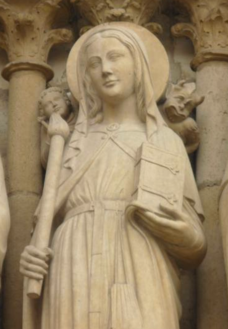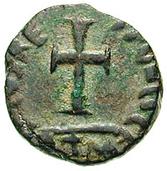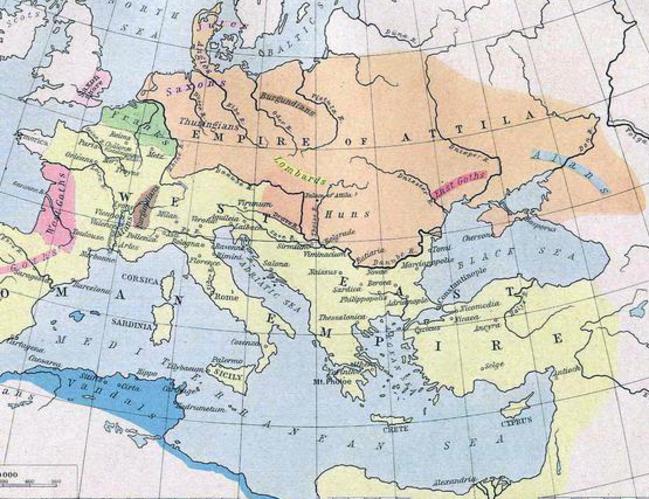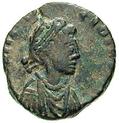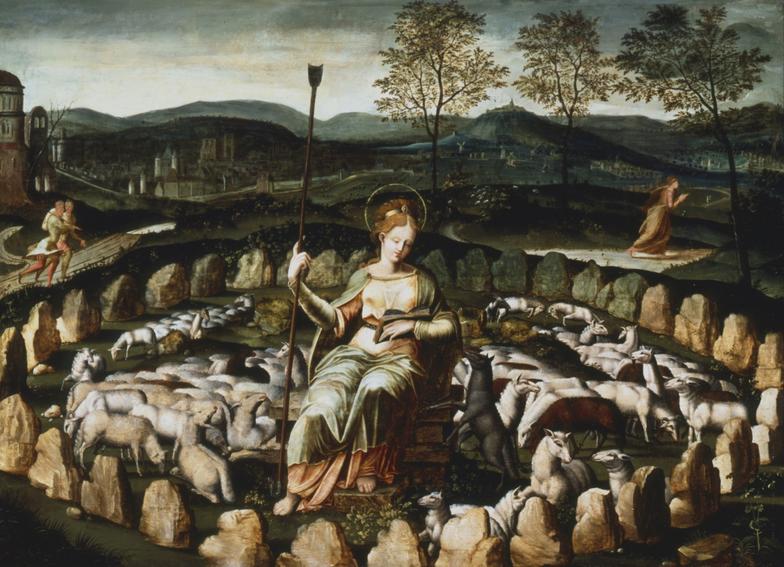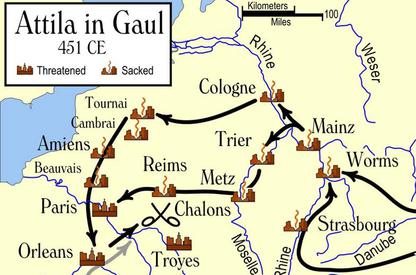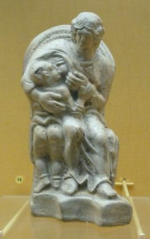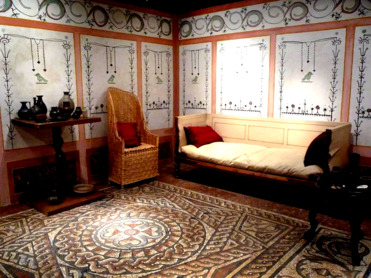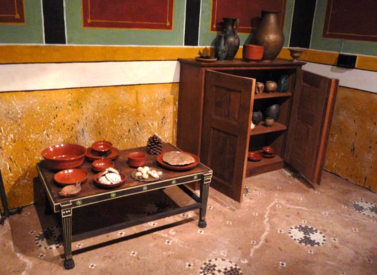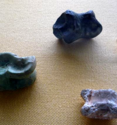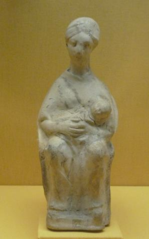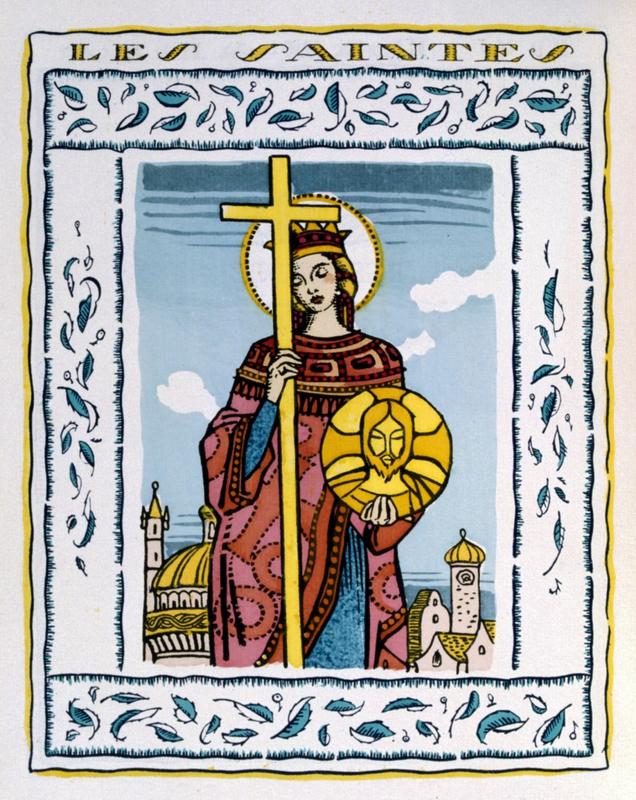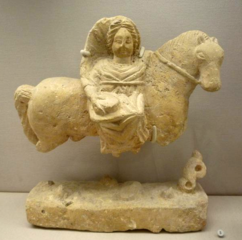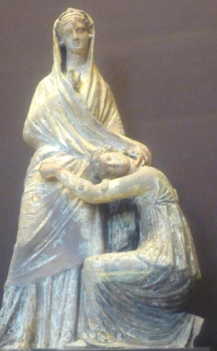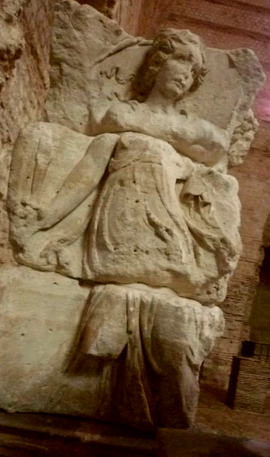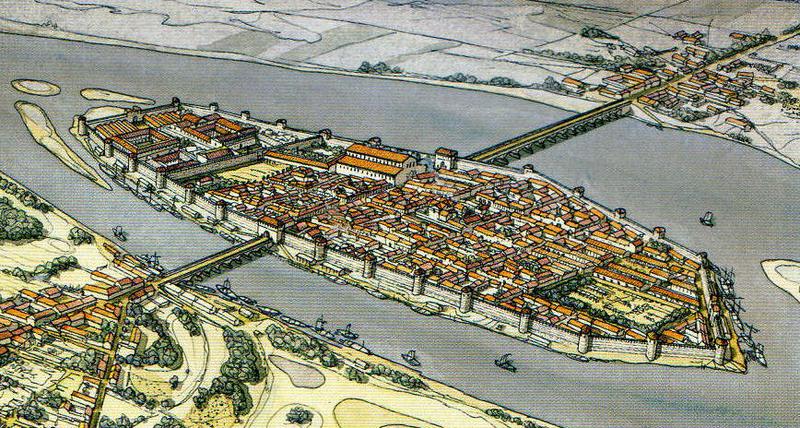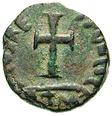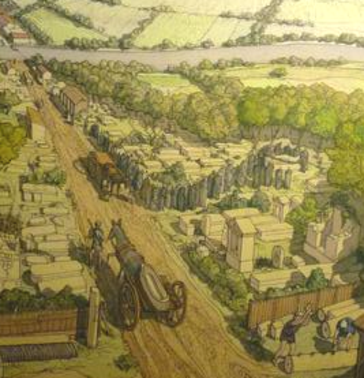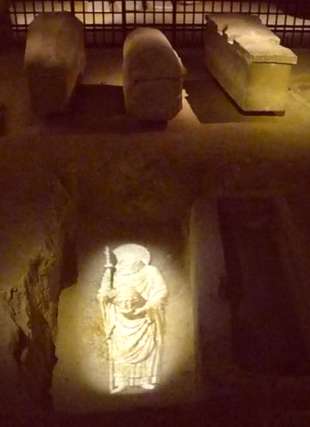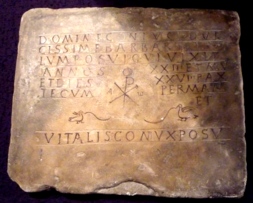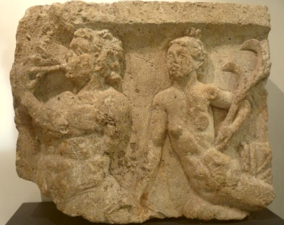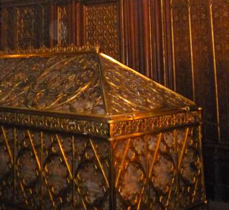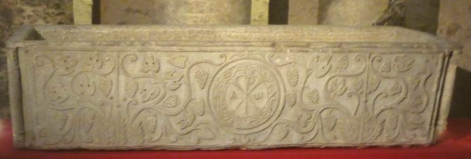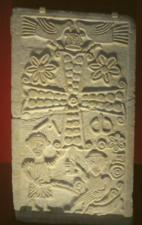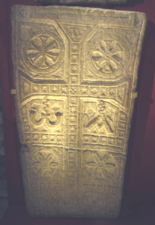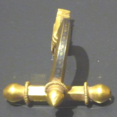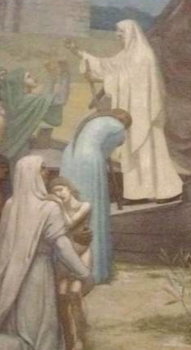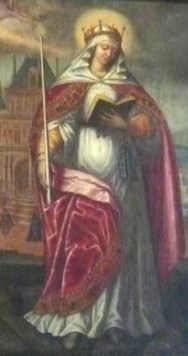Women's Travel Abroad
For Women About Women By Women
Biographies
Saint Genevieve (419 - 512 A.D.)
Patroness of Paris
A Sacred Saga From Ancient to Modern Times
You Are Welcome to Contact Me Personally With Comments or Questions
Copyright 2017 Creative Travel Publications, LLC
In the entire history of Paris no other woman can literally hold a candle to Genevieve of Nanterre. Although she lived hundreds of years ago her influence is still seen all over Paris. Today, in many Catholic churches in the city, you can find a statue that honors the crucial role Genevieve played in survival and building the early Christian community in Paris. Moreover, St. Genevieve was not just a local Parisian do-gooder, she was also esteemed as far away as Rome and Constantinople. Her sainthood was bestowed upon her by the citizens of Paris. She is, in modern terms, what we would call the people's choice for the patroness of Paris and this decision has never been contested.
Among the most visible and iconic statues of Saint Genevieve is the one above the entry door to Notre Dame de Paris Cathedral. Sculpted in fine limestone, Genevieve is portrayed as a modestly dressed young Gallo-Roman woman wearing a virgin's veil on her head and an alms purse at her waist. Saint Genevieve holds her symbols, a book for wisdom and a candle for enlightenment. Peeking mischievously over her shoulders are characters that represent good (on the left) and evil (on the right). A halo encircling her head assures us that Genevieve did indeed overcome evil using her religious knowledge and humble generosity to light the way to a better life for anyone who chose to live the Christian way.
Genevieve was born in 419 A.D. in Nanterre (Nemetoduron), an affluent rural agricultural community about seven miles away from Paris (Lutetia). In Genevieve's time Latin was the dominant language although some form of the Celtic language would have been spoken by many local residents. The people of her time would have called her Genovefa. It is generally believed her father, Severus, was a high ranking Gaulish military official and governor of Paris. While he spent time in Paris managing administrative affairs Genevieve and her mother Gerontia, a local Frankish woman, stayed in the countryside managing the family estate.
The Roman name of Genevieve's home town, Nemetoduron, is taken from the Latin word nemeto meaning sacred place and the Celtic word duron which meant enduring. Nanterre, its current name, is located about seven miles west of Paris on the east bank of the Seine River. Archaeological digs from 1994 and 2005 uncovered a large Gallic necropolis in Nanterre that dates to before the third century B.C. This ancient cemetery may be the sacred site referred to in the city's name.
In antiquity the hilly areas surrounding Nanterre were densely forested. The trees provided wood for making buildings and boats. Deforested land was dedicated to growing crops and grazing domesticated animals. Boatmen ferried produce up the river to Paris and brought luxury goods down the river to Nanterre. By 400 A.D. the town was flourishing and even had its own Christian church.
There is no scientific evidence which conclusively pinpoints the exact location of Genevieve's childhood home or the kind of house she lived in with her parents. However, archaeological research in the Seine basin where she lived has unearthed remains of both Gallic long houses and Roman villas that were occupied during Genevieve's time. Given her father's position in Roman society it is likely she spent the first years of her young life growing up in a villa rather than a long house.
Genevieve, the daughter of a high-ranking Parisian official, probably had a bedroom room of her own. The walls may have had been painted with colorful floral motifs and the heated floors might have been covered with geometric patterned mosaics. It is likely a slave slept on a straw pallet next to her bed. Living on a farm Genevieve would have been awakened at the crack of dawn and made ready for her daily activities. Her mother or a slave would have combed and braided her hair or left it hanging around her shoulders.
In Gaul most young girls wore a practical knee-length tunic made of light-weight linen or heavier wool depending on the weather. The tunic was held together at the top with a safety-pin like fibula on each shoulder and belted at the waist. In cold weather she would have worn a sleeved undergarment and added a hooded cape to keep her warm outdoors. Genevieve's shoes would have been wooden clogs or leather boots. If she wore any jewelry it was probably a simple clay bracelet or necklace.
Her parent's choice of housing would also have been determined by the family's finances and status. Roman villas were expensive to build and made a definite statement about a person's political and cultural preferences. Rural villas in Gaul were often built as an enclosed rectangular structure with separate buildings for housing and storage. Some villas had a bath house, smithy, and religious building like a temple or chapel.
The walls of the villa were constructed of clay bricks and finished with white plaster. The roof was covered with interlocking half-circle clay tiles. A wood burning furnace, under the house foundation brought heat to many of the rooms. The interior rooms faced onto a central court, the atrium or a garden, with a decorative fountain or a shallow pool for gathering rain. Rooms were often painted vibrant colors of red or green and decorated with scenes from Roman legends and myths. Rural villas sometimes had their own bathing facilities.
Genevieve's father and mother may have married at a much older age than most Romans. Frankish girls usually married later, around eighteen years old, than Roman girls, who were often married by the age of thirteen. While Gerontia's father probably exercised his Roman right of paterfamilias by choosing Severous as her husband Frankish girls could refuse a father's choice. It seems his choice was acceptable to Gerontia.
Genevieve was the only known child born to Severus and Gerontia. The fact she survived is almost miraculous. Many Roman fathers refused to raise their first born child if it was a girl instead of a boy. However, Gerontia's Gallic culture valued both male and female off-spring equally. Furthermore, as Christians they were forbidden to expose their newborn for any reason. It is most likely her parent's Gaulish values and their Christian beliefs that saved Genevieve's life.
However, Genevieve's early life may not have been all work and no play. As a child in an aristocratic Gallo-Roman family she would have been spared the more rigorous labor of household cleaning or working in the fields. It is possible in her free time she spent some of her time playing games or a musical instrument. Knucklebones, made from the knuckles of animals, was a popular game among children. Whistles and flutes were sculpted from clay into charming animals for children to play. The Romans even played a game similar to our modern day game of checkers.
Roman girls from aristocratic or rich families also learned to read and write Latin and do basic mathematics so they would be suitable partners for a prospective husband. No historian recorded whether Genovefa was educated but the sculpture of Genovefa clutching a book to her body with her her right hand, at Notre Dame Cathedral, clearly shows her as a learned woman. Certainly she would have been expected to read, write, and do math in order to assist with managing the estate. Her parents were probably her first teachers and later a tutor would have furthered her learning.
For the most part a rural villa was self-sufficient providing the owners with most of the basic necessities of life...shelter, food, and clothing. A well or spring provided water for consumption, irrigation, and bathing. Fields, orchards, and vines were planted and harvested for grain and fruit and wine. Cattle, sheep, and pigs had been domesticated in France since the Mesolithic era and continued to be a source for dairy products and meat during Gallo-Roman times.
Slaves were an integral part of the Roman work force and used at rural villas all over the Empire providing cheap agricultural, craft, and household labor. Slaves worked growing crops, tending animals, and preparing food. They often provided more specialized services like making pottery, wine, and iron goods. Educated slaves acted as tutors for their owner's children teaching languages (Greek and Latin), philosophy, and math. Other slaves cooked, cleaned, and groomed for their owners.
It is likely there were many slaves working at the Severus estate. However, it is historically believed Genevieve also helped with domestic chores by tending their sheep on the slopes of Mount Valerian and spindling wool into fiber. Genevieve's mother, wanting to be seen as a good Roman matron, probably spent many hours weaving the fiber into clothing and linens for her family and directing the household activities.
It is likely Genevieve, being a country girl, heard stories about local and foreign gods. Many people in Gaul still worshiped local female goddesses. Gaul was steeped in a tradition of tales about sacred mothers and mystical guardians. The Gallic goddess Matre Madrona and Egyptian goddess Isis watched over women and children. Epona, the goddess of equines and the harvest is shown here with her symbols of a horse and loaf of bread. She was the a popular goddess with the Roman military and the only Celtic goddess worshiped in Rome.
But Genevieve was Christian and probably preferred listening to stories about Jesus, the Apostles, martyrs, and saints. An early Christian saint, Perpetua of Carthage, actually wrote a diary of her experiences which Genevieve may have read. In The Martyrdom of Perpetua and Felicity Perpetua tells the sad tale of her persecution and death, along with other Christians, in a Carthage gladiator arena. The diary was originally written in Latin, translated into Greek, and circulated throughout the entire Roman Empire as a testament to Perpetua and Felicity's faith in Jesus and their Christian faith.
Perpetua was born in 181 A.D. into a noble family. She defied both her father and husband by converting to Christianity when she was twenty-two years old. Still nursing her newly born son Perpetua was brought in front of a judge. Despite her family's pleas Perpetua refused to give up her religious beliefs and was sentenced to die. While in prison she met a pregnant slave named Felicity. At a festival celebration in 203 A.D., two days after the birth of Felicity's daughter, both Perpetua and Felicity heroically met their death at a gladiator's sword in the amphitheater of the Roman city of Carthage, Tunisia.
Near the end of her life Empress Helena made a pilgrimage to Jerusalem in search of the holy Christian sites. During her journey she donated generously to the poor and erected places of worship. In Bethlehem she found the stable where Jesus was born. In Jerusalem she located the hill where Jesus was crucified and his burial tomb. She built churches over both of these holy sites.
She returned to Constantinople two years later with the relics from the holy cross and early apostles. Today the relics are scattered in churches throughout Europe. You can view splinters of wood and nails from the holy cross, soil from the hill on which Jesus was crucified, and the finger from Thomas who is said to have actually touched Christ's wounds, at the church of Sante Croce in Gerusalemme in the city of Rome.
Empress Helena died in Rome in around 330 A.D. at the age of eighty. Some of her body was buried in a ancient basilica on the Via Labicana. Today her tomb is on display at the Vatican Museum and her enshrined skull can be seen at the Cathedral of Saint Peter in Trier, Germany. It was Saint Helena who began the Christian tradition of relic hunting and veneration.
Both of these women became saints in eastern and western Christian religions. After Perpetua's death her diary was often read at liturgies, public worship services, especially during the Eucharist. Less than a hundred years later another woman provided heroic leadership for the followers of Christ. Flavia Iulia Helena Augusta, mother of emperor Constantine the Great, embraced Christianity shortly after her son's conversion on the battlefield. Up until then she was a staunch believer in pagan gods. Emperor Constantine legalized Christianity In 313 A.D. and it became the official religion of the Roman Empire although people did continue to worship other gods.
Ready for the day Genevieve would have gone to the household shrine for a brief service. Even though this was a Christian family her parent's were expected to offer up prayers and sacrifices for the health of the emperor and the well-being of the Roman Empire. If present Genevieve's father would have reverently led his wife, child, kin, and slaves in this worshipful practice at the family altar of Lares. He would have also burned incense and sacrificed food on behalf of his ancestors to ensure the continued prosperity of the estate.
After a morning meal of milk and bread or porridge Genevieve would have been expected to participate in the managing of the estate. Many of her waking hours were probably spent learning how to run the farm and performing household tasks. Most young Roman girls were taught how to spin, weave, and construct clothing. They also learned a myriad of other domestic skills among them how to prepare and preserve food, gather herbs to cure physical ailments, and perhaps even delivering babies (both humans and animals).
Ivory Comb Clay Bracelet Ivory Belt Buckle
National Museum of Antiquities
Saint Germain en Laye, France
Roman Living Room Roman Dining Area
City Museum of London, London, England
Clay Game Board and Stone Game Pieces
National Museum of Antiquities
Saint Germain en Laye
Games Pieces
----------
Metal Thimbles
Ivory Needles
Knucklebones
----------
Clay Flutes
Matre Madrona Epona Isis
National Museum of Antiquities
Saint Germain en Laye
Palace of
Frankish Queen Clotilde and King Clovis
Public Space
Temple to Jupiter
Boatman's Pillar
Genovefa's House
During her early childhood Genevieve probably lived a relatively quiet and somewhat isolated life in Nanterre but every so often an important event did occur. In 426 A.D., when she was just seven years old, Bishop Germanus of Auxerre and Bishop Lupus of Troyes visited her local church on their way to Britain to deal with an official church issue. Genevieve and her parents were waiting outside the church, with a crowd of other faithful Christians, to welcome the bishops.
On one occasion Genevieve's mother refused to take her to mass. Gerontia, supposedly frustrated by her daughter's constant requests to go to church, worship, and fulfill her vow, slapped Genevieve and was instantly struck blind. For almost two years Gerontia suffered from lack of sight. One day Genevieve drew water from a well. She sprinkled the water three times on her mother's eyes and made the sign of the cross. Gerontia, eyesight restored, finally agreed to let her daughter follow her religious vocation. When Genevieve was fifteen she and two older girls, went to Bourges. They received their veils from Bishop Vilicius. During the ceremony Genevieve, the youngest in the group, led the way to the altar. She vowed to live the rest of her life as a consecrated virgin to Christ and the Catholic church. Then she went back home to live a quiet religious life with her mother and father. However, after the death of her parents in 434 A. D., Genevieve moved to Paris and lived with her godmother.
Petit Pont Bridge
Grand Pont Bridge
Basilica
Roman Bath
SEINE (SEQUANA) RIVER
LEFT BANK
Military Outpost
RIGHT BANK
Commercial District
PARIS (Lutetia) and ILE DE LA CITE
400 - 500 A.D.
Illustrator: Jean Claude Golvin
Fortified Walls
Boatman's Landing
Edicts legitimizing Christianity in the Roman Empire were issued in 311 A.D. by Emperor Galerius and Emperor Constantine in 313 A.D.. Emperor Constantine's Edict of Milan stated Christians would be allowed to practice their faith without repression. In 380 A.D. Emperor Theodosius declared Christianity the official religion of the Empire. Most later emperors upheld the Edict of Milan but not all were Christians. In 360 A.D. Julian the Apostate's mutinous troops proclaimed him Emperor while they were stationed in Paris.
Jeffrey of Tours makes no mention of pagan sites in the city and surrounding environs. However, modern archaeologists have located several Roman places of worship scattered throughout Paris. The Seine River, which meanders through the Paris Basin and surrounds the Ile de Cite, was named after the revered Celtic goddess Sequana. There were temples to Roman gods Jupiter, Mars, Mercury, Romus, and Augustus on the Left Bank and the hill of Montmartre. The Egyptian goddess Isis shared a temple with the Roman goddess Ceres where the church of Saint Germain des Pres now stands.
The Pillar of the Boatman, on display in the ancient Roman baths of the Cluny Museum in Paris, attests to the fusing of Gallic and Roman gods and their enduring presence in the city. Displayed there is a limestone pillar, dedicated in 14 A.D., to Emperor Tiberius by the boatmen of Paris. It was dug up in pieces during construction of a crypt under the nave of Notre Dame Cathedral on March 6, 1710. The pillar is sculpted with images of Roman (Jupiter, Castor, Vulcan, Fortuna, and Venus) and Gallic (Esus, Cernos, Smertrios, and Rosemertus) gods and goddesses.
Also on display at the Cluny Museum is the charming sculpted relief of a youthful Leucothea. Leucothea is the Greek goddess of sailors and waterways. Some historians believe her temple was located on Mont Sainte-Genevieve where Genevieve was buried when she died. However, other historians think a temple to Bacchus occupied the top of Mont Sainte-Genevieve before the mount became Saint Genevieve's sacred shrine.
Bishop Germanus singled Genevieve out, proclaimed to everyone present her greatness, and asked Genevieve if she wanted to take an ascetic vow. She said yes, so after a series of religious rituals led by the bishops, Genevieve became a consecrated virgin. During the Eucharist mass Bishop Germanus officially sealed her commitment with a coin to signify her dedication to Christianity. He instructed her to wear only that coin. He also told her she must always "act manfully" on behalf of Christ.
In recent years there has been the question raised about how the bishops really came to know of Genevieve's youthful spritual commitment. Her hagiographer, Jeffrey of Tours, said it was because when the the bishops arrived at the church in Nanterre they sensed in her a feeling of intense holy presence. However, they could have also heard about Genevieve from her parents, family, or friends. Severus, Gerontia, and Germanus actually had a lot in common. They may have actually known each other through familial, political, or religious connections. Both Severus and Germanus were educated Roman citizens, had trained soldiers, and acted as military governors in their districts. Also, Gerontia and Germanus came from excellent Gaulish families.
At the time of Bishop Germanus visit to Nanterre Genevieve was too young to take the veil. She returned home with her parents to patiently wait for the day she could become a consecrated virgin and live solely for Christ. During this time her commitment was tested. Her mother did not seem very keen on her becoming a nun. In Germanic law Genevieve, as the only child, would inherit the entire family estate. It may be her mother felt Genevieve should marry and have children to ensure the estate stayed in the family. If she became a dedicated virgin estate land and profits would probably be given to the poor or church.
5th Century Coin
Issued By
Empress Galla Placidia
In order to serve the Holy Spirit a truly faithful Christian needed to liberated from the distractions of every day life and bonds of family. As a virgin consecrated to Christ Genevieve was expected to practice continence and chastity by loosening the bonds of duty and affection to family (This Female Man of God, Gillian Cloke). She would have learned this when she attended church, heard priestly sermons, and read the scriptures. In Corinthians 1:7 it specifically states that "the unmarried woman thinks on the things of the Lord that both in body and spirit she may be holy". So when her parents died Genevieve was finally free to begin her Christian ministry.
Living in her godmother's house, on the Ile de la Cite, Genevieve would have been surrounded by high gated city walls built to protect the city and residents from devastating river floods and foreign invaders. Around the walls boats were moored for loading local products and unloading cargo from all over the Roman Empire. Inside the walls she would have seen other homes, the palace, basilica, public gathering place, three bath houses, temple to Jupiter, and a Christian baptismal.
Looking across the Grand Pont bridge, on the right bank of the Seine River, Genevieve could see the city's commercial district. Across the Petit Pont, on the left bank were the vestiges of a once thriving Roman city including the ruins of bath houses, forum, theater, arena, and pagan temples. People would have still occupied homes in this part of the city during Genevieve's time. Also, on the west bank there were three main roads each leading to one of the city's three cemeteries.
Rue Saint Jacques
Boatman's Pillar
Cluny Museum
Paris, France
Greek Goddess Luecothea
Cluny Museum
Paris, France
Saint Denis
Notre Dame Cathedral
Paris, France
Saint Genevieve's Well
Nanterre, France
Roman Matron and Daughter
British Museum, London
By 100 A.D. many Parisians had converted to Christianity living a quiet life of devotion in the city. By the end of the 3rd century their numbers had been severely decreased. In 250 A.D. Emperor Decius issued an edict requiring all Roman citizens to offer sacrifices to the Roman gods and for the well-being of the Emperor. The sacrifices had to be made in the presence of a Roman magistrate. Once the sacrifices were performed and witnessed a written document was given certifying their religious affiliation and political loyalty.
Many early Christians refused to participate in the sacrifices and were sentenced to death. Among those who refused to sign the loyalty oath were Denis, the bishop of Paris, and the missionaries Rusticus and Eleutherius. All three were sentenced to beheading on the highest hill in Paris, the site of a pagan temple to Mercury and Mars.
According to legend Bishop Dionysus miraculously picked up his own decapitated head and walked six miles, preaching a sermon of repentence all the way, until he collapsed and died. In Saint Genevieve's day it was believed Bishop Dionysus (Saint Denis) was buried at the site of his death on the hill. It was later renamed Mons Martyrum, Mount of Martyrs. Today we call it Monmartre. Saint Denis has been worshiped as the patron saint of Paris ever since his death.
Julian worshiped the Roman god Apollo which seems unusual considering he was raised by Christian parents, educated by the Christian bishops Eusebius of Nicomedia and George of Cappadocia, and married Helena, Emperor Constantinius's Christian sister. Julian was respectful of other religions and brought the body of Emperor Constantinius II to Constantinople for burial in the Christian church of Hagia Sophia. Given his religious beliefs it seems odd Julian was also entombed there three years later.
Christians in the Roman Empire had been free to practice their religion for more than a hundred years by the time Genevieve moved to Paris to live with her godmother. At that time the population of Paris was around 8,000 people but only four percent of them were baptized Christians. With so few Christians in a city that still had residents worshiping pagan goddesses and gods Genevieve had lots of opportunities to make converts. It became her life-long mission to convert pagans to Christianity.
She choose to do this by living a devout life, extending good will to all, venerating Christian martyrs, and building places for Christians to worship. However, the people of Paris were often suspicious of her actions, generosity, and beliefs. Several times Bishop Germanus of Auxerre had to step in and lend support Genevieve in her role as a leader in the Christian church. Some historians even suggest Genevieve may have been the Bishop or Governor of Paris during her lifetime.
Early Christians usually gathered to worship in their homes or shops. They would also hold religious services in sacred burial spaces like underground catacombs within city centers or above ground cemeteries along roads leading into a city. In general Gaulish Christian leaders rarely destroyed existing Roman buildings or sites. Instead, they repurposed them as sacred places. According to Lisa M. Bitel Christianity in Gaul actually began with the commemoration of the most holy dead (Landscape With Two Saints).
Christian graves in the Roman Gaul first appeared in pagan cemeteries outside the city walls. Christians also buried their deceased among pagan dead in cemeteries lining the main left bank roads that led into Paris. Archaeologists excavated many Christian markers and coffins scattered among pagan tombs at a necropolis, two miles outside of Paris, on the Roman road that led to Orleans. Christians renamed this burial ground Necropolis Saint Marcel. They also added two other burial sites: one outside the city, Necropolis Saint Jacques on Rue Saint Jacques, and another inside the city near the Roman forum.
More Christian cemeteries were established within walking distance of the city in the third and fourth centuries. Consequently, Christian residents of Paris could easily follow the processional routes of their departed and visit their dead more frequently. Perhaps the oldest church in Paris, in vico parisiorum, was built near the tomb of a Christian woman, Crescentia, on the periphery of the city. Another church, ecclesia senior, was built early in the third century in a southeastern cemetery. The first church on the Ile de la Cite, ecclesia parisca - Church of the Parisians, rose sometime between 250 and 360 A.D.. There was a baptistery, Saint Jean la Round, on the Ile de la Cite next to the modern day Notre Dame Cathedral.
By the fifth century Christian church officials, with the permission of Emperor Theodosius, were allowed to use Roman administrative buildings and pagan shrines as churches. They often dismantled them and took the scrap material to construct entirely new places of Christian worship. Limestone quarries in Gaul were no longer functioning so masons hauled blocks from the old, abandoned public spaces of Lutetia and used them for the foundations of new Parisian basilicas. An intact pagan mausoleum could be turned into a martyrs shrine or a non-Christian's sarcophagus transformed into an altar base.
Traveling around Paris and the French countryside Genevieve would have seen many pagan religious sites. Unlike some overly zealous Christians who destroyed any pagan shrine they came upon Genevieve left them intact. Before the third century worship services were usually held in homes of prominent Christian leaders. Christians felt it was more important to build baptisteries for new converts and cemeteries for their dead.
In 285 A.D. Emperor Diocletian divided an unwieldy Roman Empire into two distinct areas hoping to make it easier to manage. The Western Empire, ruled from Rome, included most of Europe. The Eastern Empire, ruled from Constantinople, included Greece, Turkey, and Egypt. Each empire had its own emperor. By the time Genevieve was born the Western Empire and the capital city of Rome had been invaded and ravaged by the Gauls in 387 A.D. and the Visigoths in 402 A.D.
Western Roman Empire
450A.D. (Yellow, Pink, Blue, Brown)
Eastern Roman Empire
450A.D. (Yellow)
Empire of Atilla
450A.D. (Orange)
Empress Maria's Pendant
Louvre Museum
Paris, France
Roman women of the Imperial family were considered valuable commodities. Their worth was primarily determined by the familial and political ties their marriages forged between friends and enemies. In 417 A.D. Emperor Honorius forced Galla Placidia to marry his illustrious military friend Constantius III. The couple had a daughter, Justa Grata Honoria, born in 418 A.D. and a son, Valentinian III, born in 419 A.D. Her husband, Constantius III, shared the role of Emperor of the Western Empire with Honorius for seven months before his death in 421 A.D.
Unsure of her future in Emperor Honorius's court Galla Placiadia took her children to live with her brother-in-law, Emperor Theodosius, in Constantinople. During her stay in the city she would have probably heard numerous accounts of Hun attacks on the border lands of the Eastern Roman Empire.
Galla Placidia returned to Ravenna two years later when her brother died childless. Her four year old son, Valentinium was declared Augustus, Emperor of the Western Empire, in 425 A.D.. She was declared Augustus at the same time and acted as Regent from 425 A.D. to 437 A.D.. She vacated her position of regent when Valentinium was old enough to rule alone.
The Empress Galla Placidia dedicated her last years to religious endeavors. She supported leaders of the Catholic church and built an elegant family mausoleum in Ravenna. She was friends with many important church men including Genevieve's cherished spiritual mentor, Bishop Germanus of Auxerre. It is likely he told Galla Placidia of Genevieve's Christian devotion and she may have told him about the Hun invasions of the Eastern empire.
The conflict began when Justa Grata Honoria refused to marry the man her brother, the Emperor, had chosen for her. She secretly sent a letter to King Atilla, ruler of the Hun Empire, asking him to save her from the undesired match enclosing her signet ring in the missive. King Attila mistook her request for help as a marriage proposal. He believed the ring meant they were officially engaged.
As part of the marriage settlement King Attila asked Emperor Valentinium III for half of the Western Roman Empire as Justa Gratta Honoria's rightful dowry. The shocked emperor denied the legitimacy of Attila's request. Emperor Valenetinium III immediately married his sister to Flavius Bassus Herculanus, a relatively insignificant government official.
An affronted Attila refused to accept their marriage as valid and continued to press his suit. Enraged and insulted by Emperor Valentinium III's unwillingness to annul the marriage King Atilla decided to use force to claim his bride and her dowry lands. In 451 A.D. the angry King Attila and his army crossed the Rhine River ransacking and burning many of the most prosperous towns in northern Gaul.
News that King Attila the Hun was on the move struck terror in people all over upper Gaul. Parisians knew their city was directly in the path of his destructive march. It would be easy for him and his troops to invade Paris by dropping down from Amiens or coming over from Reims on their way to Orleans. Many of city's residents had already begun to pack up their household goods to leave Paris but Genevieve urged them to stay.
While Genevieve may have been as terrified as everyone else her Christian faith was strong. Many Parisians were skeptical of her leadership and opposed her plan to stay on the island. Some people even threatened to stone her to death. Fortunately Bishop Germanius's arch deacon showed up to lend her his support. Genevieve gathered together a group of Christian matrons who prayed day and night at the Baptistery Saint Jean, on the Ile de la Cite, for deliverance from King Attila's attack.
Seeing two brightly burning torches on the left bank Mount Leucotitius Genevieve knew their prayers had been answered. King Attila had bypassed Paris and headed directly south to Orleans. He and his army were defeated by the Roman general Aetius and his army of Franks, Burgundians, and Celts at the Battle of the Catalanian Plains. King Attila survived the battle and retreated with his troops to Hungary. Justa Gratta Honoria stayed married to her husband until her death.
Despite Genevieve's "manly" heroism and leadership her gender often limited her public command of the city even though she was born the daughter of a Roman governor of Paris and Bishop Germanus of Auxerre was her mentor. According to Lisa M. Bitel (Landscape With Two Saints) it was hard for any fifth century woman in Gaul, unless she was an empress like Helena or Galla Placidia, to establish civic authority. Holy women had no formal ecclesiastical roles beyond vowing chastity, praying on behalf of others, marrying a bishop, or patronizing Christian men.
With no formal training as a priest, affirmation as a bishop, or opportunity to live in a convent Genevieve had to build her reputation and power base through other socially acceptable behaviors such as demonstrating economic self-sufficiency, feminine piety, and Christian humility. After the defeat of King Attila, when she knew her beloved city of Paris and it's residents were safe, Genevieve returned to a quiet life of prayer, worship, proselytizing, self-sacrifice, and healing.
She fasted rigorously eating only beans and bread twice a week, fervently prayed in her cell for the salvation of herself and others, and religiously attended church meetings and services in one of the three churches at the Saint Marcel cemetery. Genevieve also traveled throughout the Paris Basin sharing with everyone her belief in Christ and visions of heavenly life. She gave alms to the poor and medical assistance to the sick.
By Genevieve's time Paris did have a Christian baptistery on the Ile de la Cite, several cemeteries on the left bank, and three worship sites in the Saint Marcel cemetery. Surprisingly Paris did not have a grand church like Saint Peter's in Rome or the Haga Sophia in Constantinople. Even Genevieve's small home town of Nanterre had a church large enough to attract important and generous church officials, royals, and pilgrims.
Genevieve made it part of her life's work to build churches for Christian worship. Her first building project was to construct a church over the grave of the martyred Catholic Bishop Denis of Paris. The often told story that she miraculously found his burial site has been questioned. Believers assert Genevieve instinctively knew where to find the grave because of her great love and veneration for Saint Denis. However, academic historians think she had probably heard about the location of Saint Denis's grave from church clerics.
Bishop Denis was condemned to death by the Roman governor of Paris in 250 A.D. for refusing to worship Emperor Decius as a god. Bishop Denis was beheaded on Montmatre along with his two spiritual companions, Rusticus and Eleutherius. A devout Christian woman, Catalla, buried him in a rural pagan cemetery located on the right bank of Paris about six miles outside of the city.
Genevieve frequently visited the building site to make sure the basilica was being constructed as designed. The basilica, Genevieve's Christian shrine to Saint Denis, was a rectangular, one-story structure with a truss roof. It was about 68 feet long and 26 feet wide. It is certain that inside the oratory there was an altar over Saint Denis's tomb. There may have also been some decorative elements like those used in other Christian basilicas throughout the Roman Empire such as religious paintings on the wall behind the altar, a floor paved with mosaic tiles, and a row of small windows just below the roof line. In spite of her Christian beliefs, Genevieve's church most likely had the architectural look of a pagan Roman basilica.
Genevieve decided to construct a basilica for the martyred Saint Denis. Although Genevieve owned a house in Paris and land in the countryside she did not have the finances to construct the basilica herself. She asked the priest, Genesius, to request a special offering from her fellow Christians to provide funds for its construction. It took time to get the money needed but when work on the oratory began many miracles happened. A hidden source of lime, deserted kiln, and trees for the wooden A-frame roof were providentially found near Saint Denis's tomb. Also, it was a common practice to reuse stones from abandoned Roman sites in the construction of new buildings. It is possible some of these freely scavenged stones may have found their way into the walls of the basilica.
Genevieve also concerned herself with the physical well being of the workers and worshipers at Saint Denis's oratory. When it was brought to her attention the workers were thirsty she tearfully prayed for fresh water to quench her workers thirst. On the very spot her tears fell a spring suddenly appeared. Genevieve often took her vowed sisters on prayer vigils to the shrine. If a gusty wind blew out their lighted candles she miraculously relighted the candles without a flint.
She also led processions of laypeople, an unusual practice for a Christian woman, to the oratory of Saint Denis. On several occasions she prayed to rid people afflicted with illness or madness and they were healed. Over time more and more people visited the shrine creating a "road to salvation", according to Lisa M. Bitel, from the center of city to the right bank of Paris.
Meanwhile Genevieve continued to travel the countryside sharing her faith and providing care to everyone. When Genevieve returned to Paris she was ritually welcomed by crowds of people. Her devotion, prophecies, prayers, fasting, and healing had elevated her to the status of bishop among her fellow Christians. However, Roman Catholic church officials of her day viewed her simply as a devout, chaste, Christian woman.
Saint Denis Tomb, Saint Denis Cathedral, Paris
Christian Woman's Tombstone
Crypt Archaelologique, Paris
Thirteen years after Attila's rampage Paris came under attack by the Salarian Frankish king Childeric I. During his seige Genevieve traveled the Seine River to bring grain from her estates in Meaux and Brie to the hungry people of Paris. Genevieve's helpers made the grain into bread and distributed the loaves to poor and rich regardless of their religious beliefs. In 464 A.D. Paris surrendered to King Childeric. Genevieve, a Frank on her mother's side, negotiated for the safe release of many Parisian prisoners captured in the battle.
King Childeric died in 481 A.D. His son, Clovis, became king of the Salarian Franks. That same year Clovis married a royal Burgundian woman, Clotilde, of the Catholic faith. For many years she tried to convert her pagan husband to Christianity. Finally, during one of his many battles he abandoned his pagan gods and asked the Lord Jesus for a victory. King Clovis triumphed and he, his military, and court followers were baptized in Reims, France on December 25, 496 A.D..
King Clovis and Queen Clotilde
Antoine - Jean Gros (1811 A.D.)
Petit Palais, Paris, France
Saint Genevieve in Garden With Sheep
Flemish School
Carnavalet Museum, Paris, France
King Clovis thought of himself as the Gaulish version of Constantine, the first Christian emperor of the Roman Empire. He envisioned his wife Clotilde as Constantine's mother, Empress Helena, who had converted her son to Christianity. After his baptism Clovis spent much of his time in the countryside fighting wars with renegade Arian Christians successfully expanding his territory in Gaul through religiously motivated conquests.
He and Queen Clotilde made their home in the Roman palace on the Ile de la Cite. The fortified island was strategically situated next to a navigable river, near verdant agricultural lands, and by thriving city markets. It was also an ideal location for him to rule over his Frankish homelands and newly acquired cities in southern Gaul.
While the king was away Queen Clotilde stayed in Paris to rule and raise their three sons (Chlodomer, Childebert I, and Chlothar) and a daughter (Clotilde) securely establishing the Merovingian Dynasty in Paris. She spent her time distributing alms to poor Christians, going on pilgrimages to Tours, and overseeing the building of the Basilica of the Holy Apostles, dedicated to Saint Peter and Saint Paul.
Construction of the Basilica of the Holy Apostles, meant to be a family mausoleum, began on the evening of Clovis's campaign against the Arian Goths. The church was built near the Roman forum on a left bank hilltop that had been a protective look out spot for centuries. It was about the size of Genevieve's basilica for Saint Denis. The rectangular basilica was made of stones gathered from abandoned Roman buildings. The entrance had a triple portico and inside there was a lofty wooden roof and ceremonial altar. Paintings of prophets, patriarchs, martyrs, and confessors adorned the exterior and interior of the church.
Cruciform Fibula Cloisonne Imperial Bees and Horsehead Belt Buckle Cruciform Fibula Merovignian Exhibit, 2016
Cluny Museum, Paris, France
Before her death on January 3, 512 A.D. Genevieve had informally acted as the Catholic bishop of Paris, influenced Frankish administrative policy, performed miraculous cures and deeds, and lived a devoutly Christian life. She was highly respected by Roman Catholic church officials, revered by King Clovis and Queen Clotilde, and beloved by the Christian people of Paris. In her life time she built a basilica to Saint Denis and helped King Clovis and Queen Clotilde design the Basilica of the Holy Apostles.
Genevieve was buried in a plain limestone coffin, wearing an unadorned white gown and mantle, at a cemetery atop Mont de Paris on the Left Bank of Paris. When Queen Clotilde finished building her church she moved Genevieve's sarcophagus from its make-shift wooden shrine to the Basilica of the Holy Apostles. Genevieve's coffin was interred under the altar of the new church. At the time of their deaths King Clovis, Queen Clotilde, and several family members were also interred in the basilica next to Genevieve's coffin.
Placing the tomb in the mausoleum ensured the Merovingian family had their own resident saint. The Basilica of the Holy Apostles became an important pilgrimage site. Legions of Christians visited the basilica to venerate Saint Genevieve, pay homage with valuable gifts, and pray for miracles and cures. The church was later renamed the Basilica of Saint Genevieve.
Saint Genevieve
Chapels, Relic, Sarcophagus
Church of Saint Etienne-Du-Mont
Paris, France
Merovignian Sarcophagus and Tombstones with Christian Symbols
Merovingian Exhibit 2016
Cluny Musem, Paris, France
Saint Genevieve can be recognized by her iconic symbols: a spindle, lamb, candle, book, alms purse, or pendant. Perhaps, the most famous and accessible image of her can be found on the front of the Cathedral of Notre Dame de Paris. This statue shows her with an angelic-looking imp behind her right shoulder and a devilish-looking imp behind her left shoulder. It depicts a very human woman reminding us that Saint Genevieve, like us, had to deal with difficult choices and live with the outcome of her decisions.
Another more modern statue of Saint Genevieve perches atop a monumental 46 foot pillar on a bridge, Pont de la Tournelle, crossing the Ile Saint Louis. Paul Landowski sculpted his grand 18 foot Art Deco statue of Saint Genevieve in 1928 . He portrayed the saint with her hands tenderly enfolding a young girl who is holding a boat, the traditional icon of the city of Paris. The location of this statue, overlooking the Seine River, is placed to let everyone know Saint Genevieve is still the protector of their beloved city.
Genevieve's sincere adherence and practice of her Christian beliefs may explain why Parisians choose her to be the patroness saint of their city. She always acted in the best interests of everyone and constantly worked for peace and prosperity. Over the centuries many miracles have been attributed to her and modern day believers still pray to Saint Genevieve for help and blessings during times of hardship.
Sadly, the Basilica of Saint Genevieve no longer exists. Like many other Parisian buildings from the Roman period her basilica and sarcophagus were damaged, dismantled, and destroyed by foreign invasions, civic revolts, and urban renewal. However, the remains of Saint Genevieve can be found in her chapel at the church of Saint Etienne du Mont, Paris.
Before Woody Allen's film, Midnight in Paris, it was possible to visit the church almost any time during the day. Recently the church priests have limited entrance to the church to selected times in the morning and afternoon. Even if the church is open the gate to Genevieve's chapel may be closed during religious services. However, do not be too disappointed if the church is closed. You will find statues, paintings, and stained glass panels of the blessed Saint Genevieve all over Paris.
Pantheon
Paris, France
Carnavalet Museum
Paris, France
Church of Saint Clotilde
Paris, France
Luxemburg Garden
Paris, France
PARIS
Notre Dame Cathedral, Paris, France
Roman Rural Villa
Gaulish Long House
Christian Baptistery
Saint Jean la Round
Antiquities Museum
Saint Germain en Laye
Mercury and Neried
Carnavalet Museum
Paris, France
Cemetery Saint Marcel, Paris
Emperor Honorius, ruler of the Western Roman Empire, was eighteen years old when the Visigoths attacked Rome. Fearful for his life he fled Rome with his wife, Empress Maria and court leaving behind his sister, Galla Placidia. She was captured by the Visigoth leader, King Alaric, and held captive for ranson. The Emperor and his entourage traveled around Italy while the military General Stilicho, his wife's father, battled to push the Visigoth invaders back to their homeland in Spain.
Emperor Honorius, overwhelmed with the expense of war, could not afford to pay Galla Placidia's ransom. His sister spent almost fifteen years with the embattled Visigoths. When Alaric died in 414 A.D. she married Ataulf, the new Visigoth leader. The same year they had a son, Theodosius, who died shortly after his birth. By 415 A.D. her husband was dead and the Visigoths defeated. Galla Placidia was returned to her family, in the new Roman capital of Ravenna, as part of Rome's peace treaty with the Visigoths.
Western and Eastern Roman Empire and Hun Empire, 450 A.D.
Bishop Germanus died in 448 A.D. during a visit to Galla Placidia's court in Ravenna. The Empress died two years later in Rome. It is improbable that either of them could have forseen the havoc Galla Placidia's daughter, Justa Grata Honoria, would cause in Gaul or the role Genevieve played in changing the history of Paris and saving the lives of the people of the city.
Illustrator: Jean Claude Golvin
Illustrator: Jean Claude Golvin
Illustrator: Jean Claude Golvin

